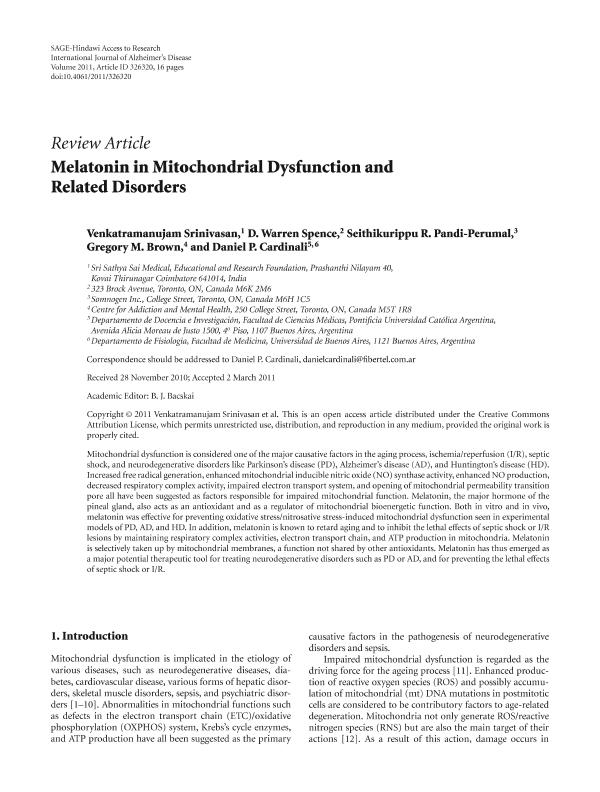Artículo
Melatonin in mitochondrial dysfunction and related disorders
Srinivasan, Venkatramanujam; Spence, David Warren; Pandi Perumal, Seithikurippu R.; Brown, Gregory M.; Cardinali, Daniel Pedro

Fecha de publicación:
03/2011
Editorial:
Hindawi Publishing Corporation
Revista:
International Journal of Alzheimer's Disease
ISSN:
2090-0252
Idioma:
Inglés
Tipo de recurso:
Artículo publicado
Clasificación temática:
Resumen
Mitochondrial dysfunction is considered one of the major causative factors in the aging process, ischemia/reperfusion (I/R), septic shock, and neurodegenerative disorders like Parkinson's disease (PD), Alzheimer's disease (AD), and Huntington's disease (HD). Increased free radical generation, enhanced mitochondrial inducible nitric oxide (NO) synthase activity, enhanced NO production, decreased respiratory complex activity, impaired electron transport system, and opening of mitochondrial permeability transition pore all have been suggested as factors responsible for impaired mitochondrial function. Melatonin, the major hormone of the pineal gland, also acts as an antioxidant and as a regulator of mitochondrial bioenergetic function. Both in vitro and in vivo, melatonin was effective for preventing oxidative stress/nitrosative stress-induced mitochondrial dysfunction seen in experimental models of PD, AD, and HD. In addition, melatonin is known to retard aging and to inhibit the lethal effects of septic shock or I/R lesions by maintaining respiratory complex activities, electron transport chain, and ATP production in mitochondria. Melatonin is selectively taken up by mitochondrial membranes, a function not shared by other antioxidants. Melatonin has thus emerged as a major potential therapeutic tool for treating neurodegenerative disorders such as PD or AD, and for preventing the lethal effects of septic shock or I/R.
Palabras clave:
MITOCHONDRIAL DYSFUNCTION
,
AGING
,
ALZHEIMER´S DISEASE
,
MELATONIN
Archivos asociados
Licencia
Identificadores
Colecciones
Articulos(SEDE CENTRAL)
Articulos de SEDE CENTRAL
Articulos de SEDE CENTRAL
Citación
Srinivasan, Venkatramanujam; Spence, David Warren; Pandi Perumal, Seithikurippu R.; Brown, Gregory M.; Cardinali, Daniel Pedro; Melatonin in mitochondrial dysfunction and related disorders; Hindawi Publishing Corporation; International Journal of Alzheimer's Disease; 2011; 3-2011; 1-16
Compartir
Altmétricas



